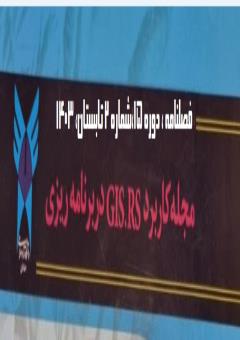تجزیه و تحلیل مکانیابی محل دفن پسماندشهری مطالعه موردی: شهر ایذه
محورهای موضوعی : کاربرد GIS&RS در محیط زیست
محمدابراهیم عفیفی
1
,
مجتبی محمدی
2
,
عبدالرسول قنبری
3
![]()
1 - استادیار داشگاه آزاد اسلامی واحد لارستان
2 - علوم انسانی، دانشکده جغرافیا، دانشگاه آزاد اسلامی،لارستان، ایران
3 - ستادیار جغرافیا، دانشگاه آزاد اسلامی واحد لارستان
کلید واژه:
چکیده مقاله :
برنامهریزی و مدیریت شهری نیازمند نگرش سیستماتیک و همه جانبه به ابعاد مختلف شهر است. یکی از ابعاد شهری که در صورت عدم مدیریت صحیح باعث ایجاد اختلال در محیط جغرافیایی شهر میشود. مدیریت و مکانیابی دفع پسماندهای شهری میباشد. در دهههای اخیر رشد بیرویه جمعیت و توسعه شهر نشینی موجب بروز انواع ناسازگاریهای اجتماعی، اقتصادی و زیست محیطی نظیر تولید انواع پسماندهای جامد شهری شده است که دفن غیر اصولی آن را به دنبال داشته است. به طوری که امروزه چگونگی دفن، مکانیابی و مدیریت صحیح محل دفن زبالههای جامد به عنوان یکی از معضلات زیست محیطی شهری تبدیل شده است. بنابراین یافتن محل مناسب برای این مهم از اهداف اصلی و اولیه طرحهای توسعه شهری جهت نیل به توسعه پایدار میباشد. پژوهش حاضر از نظر هدف، نظری-کاربردی و از لحاظ روش مطالعه توصیفی-تحلیلی و هدف آن مکانیابی محل دفن پسماندهای شهر ایذه با استفاده از سیستمهای اطلاعات جغرافیایی و فرایند تحلیل سلسله مراتبی فازی میباشد. هدف از این پژوهش مکانیابی محل دفن پسماند شهری ایذه با استفاده از روشهای تصمیمگیری چند معیاره است ابتدا با گردآوری اطلاعات پایه، نقشهها و تصاویر ماهوارهای مورد نیاز، چندین لایه اطلاعاتی بر مبنای شاخصهای ژئومورفولوژیکی، اقلیمی، زیست محیطی و اقتصادی ایجاد میشود این لایهها عبارت است از شیب، شکل زمین، لیتولوژی، گسل، آبهای سطحی، آبهای زیرسطحی، عمق سطح ایستایی، مناطق متأثر از باد، مناطق تحت حفاظت، شهر و جهات توسعهی آن خطوط انتقال نیرو، زمینهای زراعی و حساس از نظر زیست محیطی و در نهایت نقشه کاربری اراضی میباشند لایههای مذکور از نقشههای موجود در محیط gis تهیه و تولید شده سپس با استفاده از دادههای ماهوارهای و عملیات میدانی به روز میگردند و تحلیلها مبتنی بر لایههای ایجاد شده صورت میگیرد و مکانهای پیشنهادی ارائه میگردد.
Urban planning and management requires a systematic and comprehensive approach to different aspects of the city. One of the dimensions of the city which, if not properly managed, causes disturbance in the geographical environment of the city. management and location of urban waste disposal. In the recent decades, the excessive growth of the population and the development of urbanization have caused all kinds of social, economic and environmental incompatibilities, such as the production of all kinds of urban solid waste, which has been followed by improper burial. So that today, how to properly bury, locate and manage solid waste landfills has become one of the urban environmental problems. Therefore, finding the right place for this is one of the main and primary goals of urban development plans to achieve sustainable development. The current research is theoretical-applicative in terms of its purpose and descriptive-analytical in terms of study method and its purpose is to locate the waste burial site of Izeh city using geographic information systems and fuzzy hierarchical analysis process. The purpose of this research is to locate the landfill site of urban waste in Izeh using multi-criteria decision-making methods, first by collecting basic information, maps and required satellite images, several layers of information based on geomorphological, climatic, environmental and economic indicators. These layers are slope, landform, lithology, fault, surface water, subsurface water, depth of static surface, areas affected by wind, protected areas, city and its development directions, power transmission lines, land agricultural and environmentally sensitive and finally the land use map, the mentioned layers are prepared and produced from the maps available in the gis environment, then they are updated using satellite data and field operations, and the analyzes are based on The created layers are created and the proposed locations are provided


